These are animals we saw (but did not study) while conducting deep-sea research.
Surface Animals
In Moss Landing, CA, we see many seabirds and otters while leaving port. At sea, whales, dolphins and porpoises, as well as seabirds, often visit the ship, sometimes in the hundreds!
Click photos for larger images |
 |
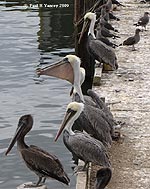 |
 |
 |
 |
| Sea otter at Moss Landing, CA |
Pelicans at Moss Landing
(righthand picture I call "Tweedledee, Tweedledum, Tweedle-d'oh!) |
Dahl's porpoises
Heather Groshong's
35mm film images (2001): click for superb closeups |
 |
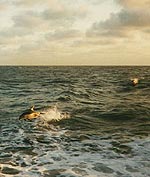 |
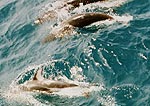 |
|
|
Tara Goldsmith's 35mm film images (1996)
Porpoises porpoising
More porpoising ; 2 species
(Finless and Dahl's porpoises) |
|
|
| |
Birds
Click photos for larger images
|
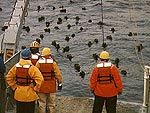 |
 |
 |
 |
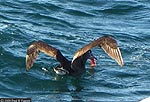 |
Hitchcockian scene:
researchers and albatrosses await the returning net |
Albatrosses follow the ship, arriving in large numbers when we bring up a net. In two scenes, you can see them eating or fighting over red fish that we threw back in after a trawl. |
 |
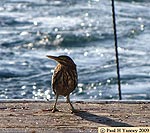 |
 |
 |
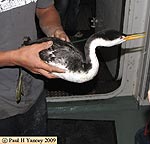 |
| Albatrosses |
One eerie day in Oct. 2009 on the R/V Point Sur on the Pacific west of Monterey Bay, numerous LAND bird species plus an exhausted grebe (righthand pictures) came to the ship, some spending most of the day on board! Some kept flying into the ship's lab and engine room. Very strange behavior. |
| |
Other Animals
Click photos for larger images |
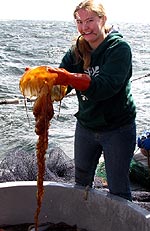 |
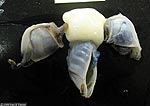 |
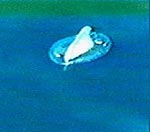 |
 |
 |
| Large jellies in huge numbers invade Monterey Bay in Aug-Sept. 2009 |
Pelagic barnacles drift in the currents with their own float! |
Sailing Velella
[colonial hydrozoan] |
Leptocephalus of eel
(juvenile/larval) |
Pelagic snail? Or?
(heteropod?) |
| |
| Frames from a video of a pinniped visitor |
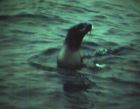 |
 |
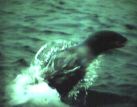 |
 |
|
Frames from a video of leaping porpoises |
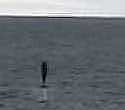 |
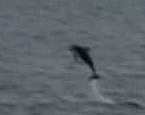 |
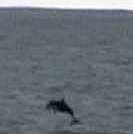 |
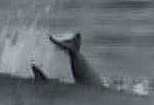 |
|
| Leaping and bellyflopping |
Tailslapping display to a nearby porpoise |
|
| Videos of porpoises in the wild |
|
|
|
| Video of 2 porpoises saving energy by riding the ship's bow-wave (and having fun?) |
Video of a porpoise leaping near the ship |
Video of a porpoise jumping and slapping its tail |
News on Naval Sonar and Cetaceans
- Nov. 2008 : The Supreme Court rules in favor of the Navy, allowing continued testing of their sonar that may be disturbing marine mammals--see below
- May 2003 : New evidence shows that Navy sonar disturbs orcas and porpoises in the wild--see the SoundNet article . Earlier news: In Dec. 2001 , the Navy finally admitted that its new low-frequency sonar--described below--caused the beaching of 16 whales in the Bahamas in Mar. 2000. Six animals died on the beach, and they all had hemorrhaging around their ears.
- In the Jan. 26 2001 issue of Science (p. 576) and the Mar. 5, 1998 issue of Nature (p.29) , evidence is presented that strongly links the US Navy's testing of its Low Frequency Active Sonar (LFAS ) with mass beaching and dying of whales . The 1998 study shows that precisely during the spring 1996 testing of LFAS near Greece, beachings of beaked whales jumped almost 20-fold in the exact area of testing. While not 100% conclusive, the study makes it very possible that this extremely loud sound device, designed to detect quiet submarines, interferes with the sensitive sound-making and hearing of whales. The 2001 article discusses research on human sonar and beaching incidents in the Bahamas. For more information, see San Francisco Medical Foundation's LFAS Site , and the LFAS Issues Site .
Whale Beaching
Why do whales often beach themselves, usually dying in the process? (See CNN for recent news stories and videos of beached whales: California Grey Whales , Australian Sperm Whales ) (and NY Times on East Coast Dolphins ). There are many hypotheses (e.g., confusion by disease; inability of their sonar to detect gently sloping sand) but no clear answers. An hypothesis of mine is that whales may run up onto beaches when a primitive urge to return to land is triggered by certain dangers. After all, whales' immediate ancestors were semi-terrestrial (clearly shown in the fossil record). They possibly went to sea to feed and to land to escape danger.
Other marine mammals, even those awkward on land--seals, seal lions for example--still do this, because isolated beaches have fewer large predators than the ocean. And some researchers suggest that sunbathing in the air helps seals to heal wounds and kill skin parasites. Whales ancestors may have done the same. Perhaps deep in their brains is a remnant of this behavior, triggered only by new or extreme dangers that their normal behaviors and higher brain centers cannot cope with.
Since this beaching behavior is not adaptive to modern, non-terrestrial whales, it could be an example of an evolutionary vestige: a once-useful feature no longer of value. We humans have many such vestigal behaviors; examples include the raising of our few hairs when we are cold or scared (useful in a hairy animal like a cat to trap warm air or to look big, but not useful in us); and our craving for sweet and fat (once useful in times of food scarcity, but detrimental in societies with plentiful food). (AND--why do humans like to be in water so much?) Next: Fishes - Bathyal and Abyssal .... |
|